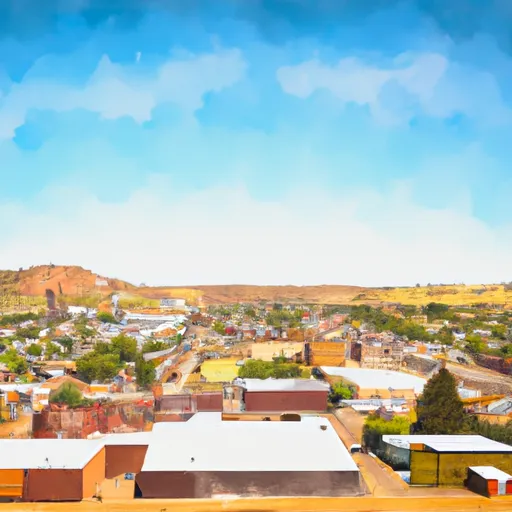-
 Snoflo Premium
Snoflo Premium
Get unlimited access to all our content
With no Ad interruptions! - Start Your Free Trial Login with existing account
Morenci
Eden Index
Climate
9.1
•
Recreation
6.2
•
Community
3.0
•
Safeguard
6.6/10

Morenci, Arizona is a small town located in Greenlee County in the southeastern part of the state. It has a semi-arid climate with hot summers and mild winters. Summers in Morenci can be quite hot, with temperatures often reaching the triple digits, while winters are relatively mild with temperatures averaging in the 50s.
The hydrology constituents of Morenci are primarily influenced by the nearby San Francisco River. The river provides water for irrigation and plays a vital role in the local ecosystem. The town also benefits from the nearby Clifton Reservoir, which helps with water supply.
Outdoor recreation opportunities in Morenci are abundant. The surrounding area features beautiful landscapes, including the Coronado National Forest and Gila Wilderness. These areas offer opportunities for hiking, camping, and wildlife viewing. Fishing enthusiasts can enjoy the San Francisco River, which is known for its trout population. Morenci also has a golf course for those who enjoy the sport.
Overall, Morenci offers a unique combination of a semi-arid climate, hydrological features, and diverse outdoor recreation opportunities for residents and visitors alike.
What is the Eden Index?
The Snoflo Eden Index serves as a comprehensive rating system for regions, evaluating their desirability through a holistic assessment of climate health, outdoor recreation opportunities, and natural disaster risk, acknowledging the profound impact of these factors on livability and well-being.
Climate Health Indicator (CHI): 9.1
Morenci receives approximately
355mm of rain per year,
with humidity levels near 58%
and air temperatures averaging around
18°C.
Morenci has a plant hardyness factor of
9, meaning
plants and agriculture in this region tend to thrive here all year round.
By considering the ideal temperature range, reliable water supplies, clean air, and stable seasonal rain or snowpacks, the Climate Health Indicator (CHI) underscores the significance of a healthy climate as the foundation for quality living.
A healthy climate is paramount for ensuring a high quality of life and livability in a region, fostering both physical well-being and environmental harmony. This can be characterized by ideal temperatures, reliable access to water supplies, clean air, and consistent seasonal rain or snowpacks.
Weather Forecast
Streamflow Conditions
Upper Gila
Area Rivers
Upper Gila
Snowpack Depths
Upper Gila
Reservoir Storage Capacity
Upper Gila
Groundwater Levels
Recreational Opportunity Index (ROI): 6.2
The Recreational Opportunity Index (ROI) recognizes the value of outdoor recreational options, such as parks, hiking trails, camping sites, and fishing spots, while acknowledging that climate plays a pivotal role in ensuring the comfort and consistency of these experiences.
Access to outdoor recreational opportunities, encompassing activities such as parks, hiking, camping, and fishing, is crucial for overall well-being, and the climate plays a pivotal role in enabling and enhancing these experiences, ensuring that individuals can engage in nature-based activities comfortably and consistently.
Camping Areas
| Campground | Campsites | Reservations | Toilets | Showers | Elevation |
|---|---|---|---|---|---|
| Honeymoon | 4 | 5,433 ft | |||
| Hannagan | 8 | 9,130 ft | |||
| KP Cienega | 5 | 8,970 ft | |||
| Granville | 12 | 6,745 ft | |||
| Upper Juan Miller | 4 | 5,787 ft | |||
| Lower Juan Miller | 4 | 5,780 ft | |||
| Hot Well Dunes | 10 | 3,639 ft | |||
| Strayhorse | 7 | 7,773 ft | |||
| Owl Creek | 7 | 3,413 ft | |||
| Riverview | 13 | 3,132 ft |
Nearby Fishing
Nearby Ski Areas
Catastrophe Safeguard Index (CSI):
The Catastrophe Safeguard Index (CSI) recognizes that natural disaster risk, encompassing floods, fires, hurricanes, and tornadoes, can drastically affect safety and the overall appeal of an area.
The level of natural disaster risk in a region significantly affects safety and the overall livability, with climate change amplifying these risks by potentially increasing the frequency and intensity of events like floods, fires, hurricanes, and tornadoes, thereby posing substantial challenges to community resilience and well-being.
Community Resilience Indicator (CRI): 3.0
The Community Resilience Indicator (CRI) recognizes that education, healthcare, and socioeconomics are crucial to the well-being of a region. The CRI acknowledges the profound impact of these elements on residents' overall quality of life. By evaluating educational resources, healthcare accessibility, and economic inclusivity, the index captures the essential aspects that contribute to a thriving community, fostering resident satisfaction, equity, and social cohesion.

